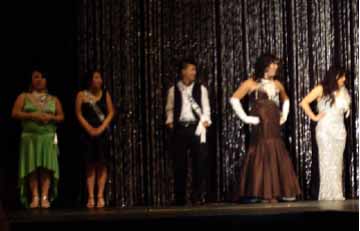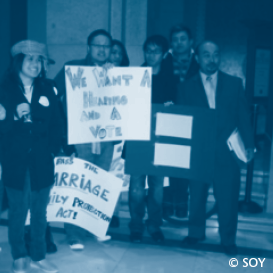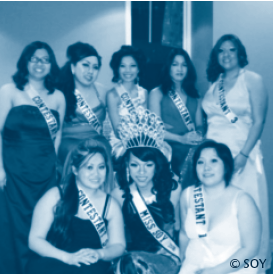Difference between revisions of "Shades of Yellow (SOY)"
(table +table +table) |
|||
| Line 4: | Line 4: | ||
| − | Hmong, Laotian, Vietnamese, and other ethnic populations that lived on the Indochinese Penninsula migrated to the United States following the fall of Saigon, which ended the Vietnam War in 1975. The United States government initially granted only 3,466 people asylum from communist-controlled Vietnam—in 1976, this number jumped to 11,000. | + | Hmong, Laotian, Vietnamese, and other ethnic populations that lived on the Indochinese Penninsula migrated to the United States following the fall of Saigon, which ended the Vietnam War in 1975.<small>(1)</small> The United States government initially granted only 3,466 people asylum from communist-controlled Vietnam—in 1976, this number jumped to 11,000.<small>(2)</small> |
| − | |||
{| {{prettytable}} | {| {{prettytable}} | ||
! | ! | ||
| Line 14: | Line 13: | ||
'''Soy Pageant, photo by Diana Vang.''' | '''Soy Pageant, photo by Diana Vang.''' | ||
</div> | </div> | ||
| − | |Time progressed, and the initial immigrant communities California, Washington and Texas resettled in Minnesota. These people, many of whom assisted the U.S. government in Vietnam War, were in danger of losing their lives. By 1981, this community included 9,200 people. In 2000, the population amounted to an estimated 42,000. | + | |Time progressed, and the initial immigrant communities California, Washington and Texas resettled in Minnesota. These people, many of whom assisted the U.S. government in Vietnam War, were in danger of losing their lives. By 1981, this community included 9,200 people. In 2000, the population amounted to an estimated 42,000.<small>(3)</small> |
| − | The Capital City maintains one of the largest urban Hmong populations in the United States. Social worker Phia Xiong and community member Xeng Lor established the group as the first social organization for GLBT Hmong people in recorded history. | + | The Capital City maintains one of the largest urban Hmong populations in the United States. Social worker Phia Xiong and community member Xeng Lor established the group as the first social organization for GLBT Hmong people in recorded history.<small>(4)</small> |
|} | |} | ||
| Line 25: | Line 24: | ||
! | ! | ||
|- | |- | ||
| − | | The two began with simple social gatherings that served as a forum for community discussions—coffee hours, potlucks, and other informal meetings brought up “issues [GLBT Hmong people] face at home, school, work, and/or in the community.” | + | | The two began with simple social gatherings that served as a forum for community discussions—coffee hours, potlucks, and other informal meetings brought up “issues [GLBT Hmong people] face at home, school, work, and/or in the community.”<small>(5)</small> |
| − | As the population of Hmong people increased exponentially, so did the pressing need for a formal organization. The “conservative” traditions of the Hmong population leave little room for family acceptance of same-sex relationships. A 2006 issue of the Advocate noted that “there’s not even a word for gay in Hmong.” | + | As the population of Hmong people increased exponentially, so did the pressing need for a formal organization. The “conservative” traditions of the Hmong population leave little room for family acceptance of same-sex relationships. A 2006 issue of the Advocate noted that “there’s not even a word for gay in Hmong.”<small>(6)</small> |
| [[Image:Svc_soylobby.png]] | | [[Image:Svc_soylobby.png]] | ||
|} | |} | ||
| Line 45: | Line 44: | ||
| − | Soy New Year, the group’s main annual event, includes a drag pageant that encourages young Hmong men and women to don the traditional clothing of their culture in a completely untraditional way. In 2009, Philanthrofund granted the organization $7,500 to continue its important work in the present year. | + | Soy New Year, the group’s main annual event, includes a drag pageant that encourages young Hmong men and women to don the traditional clothing of their culture in a completely untraditional way. In 2009, Philanthrofund granted the organization $7,500 to continue its important work in the present year.<small>(7)</small> |
|} | |} | ||
| Line 52: | Line 51: | ||
| − | <small>(1)</small> | + | <small>(1)</small> Deaux, Kay. ''To Be an Immigrant.'' New York: Russell Sage Foundation, 2006. Page 18. |
| + | |||
| + | <small>(2)</small> Mason, Sarah R. ''They Chose Minnesota: A Survey of the State's Ethnic Groups.'' St. Paul: Minnesota Historical Society, 1981. Page 581. | ||
| + | |||
| + | <small>(3)</small> Mason, Sarah R. ''They Chose Minnesota: A Survey of the State's Ethnic Groups.'' St. Paul: Minnesota Historical Society, 1981. Page 580. | ||
| − | <small>( | + | <small>(4)</small> http://genderandequity.org/partners-soy |
| − | <small>( | + | <small>(5)</small> http://www.shadesofyellow.org/page24213811.aspx?print=Y |
| − | <small>( | + | <small>(6)</small> Ong, Bao. "Group to Watch: Shades of Yellow." ''The Advocate,'' 4/25/2006. Page 30. |
| − | <small>( | + | <small>(7)</small>http://www.pfundonline.org/grantees.html |
Part of [[Minneapolis/St. Paul, MN: 100 Queer Places in Minnesota History, (1860-1969), (1969-2010)]] | Part of [[Minneapolis/St. Paul, MN: 100 Queer Places in Minnesota History, (1860-1969), (1969-2010)]] | ||
Revision as of 19:39, 27 March 2010
379 University Aveenue West, St. Paul, MN (2003-Present)
Hmong, Laotian, Vietnamese, and other ethnic populations that lived on the Indochinese Penninsula migrated to the United States following the fall of Saigon, which ended the Vietnam War in 1975.(1) The United States government initially granted only 3,466 people asylum from communist-controlled Vietnam—in 1976, this number jumped to 11,000.(2)
| Time progressed, and the initial immigrant communities California, Washington and Texas resettled in Minnesota. These people, many of whom assisted the U.S. government in Vietnam War, were in danger of losing their lives. By 1981, this community included 9,200 people. In 2000, the population amounted to an estimated 42,000.(3)
|
(1) Deaux, Kay. To Be an Immigrant. New York: Russell Sage Foundation, 2006. Page 18.
(2) Mason, Sarah R. They Chose Minnesota: A Survey of the State's Ethnic Groups. St. Paul: Minnesota Historical Society, 1981. Page 581.
(3) Mason, Sarah R. They Chose Minnesota: A Survey of the State's Ethnic Groups. St. Paul: Minnesota Historical Society, 1981. Page 580.
(4) http://genderandequity.org/partners-soy
(5) http://www.shadesofyellow.org/page24213811.aspx?print=Y
(6) Ong, Bao. "Group to Watch: Shades of Yellow." The Advocate, 4/25/2006. Page 30.
(7)http://www.pfundonline.org/grantees.html
Part of Minneapolis/St. Paul, MN: 100 Queer Places in Minnesota History, (1860-1969), (1969-2010)


